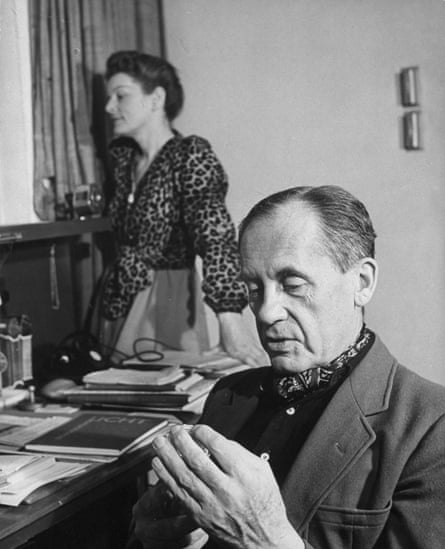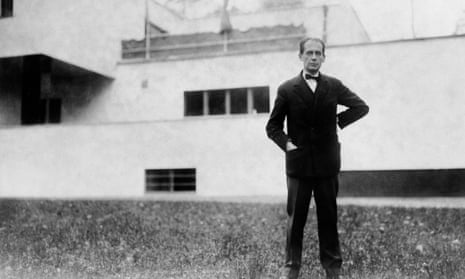Maybe it started with his name: Gropius. Ugly, strange, hard to place, not even obviously German, more suited to a microbe or a medical condition than a person. Then Walter – a touch comical, archaic, swotty. It – that is, the development of the public perception of the famous architect – continued with certain serious-going-on-scowling photographs of the man, with Evelyn Waugh’s satire of him in Decline and Fall as the doctrinaire Otto Silenus, and with the unflattering memoir of his ex-wife Alma Mahler. A “tired twilight” was how she described their marriage.
For whatever reason, the image of Walter Gropius is generally that of a dry old stick, the name polemicists used to wield (for example, Tom Wolfe in From Bauhaus to Our House) when they wanted to berate modernist architecture for its soulless functionalism. It is a version of the man that Fiona MacCarthy wants to dispel.
Ever since she revealed that Eric Gill, revered sculptor and devout catholic, was a serial abuser of his daughters, MacCarthy’s approach to biography has been to combine an appreciation of design and art with a willingness to delve into the personal lives of her subjects. This book is no exception. Amid studious accounts of his artistic development, his influences and impacts, she recounts his stormy affair with Alma, which started when the composer Gustav, her first husband, was still alive.

MacCarthy prints letters in which, for example, Alma says just what she would like to do with Walter’s “sacred appendage”. The book later recounts Gropius’s marriage to Ilse (later changed to Ise) Frank which, despite her affair with the Bauhaus typographer Herbert Bayer, was ultimately successful and enduring. Gropius’s ways of dealing with this crisis included going on a “naked picnic” with Bayer, without Ise, and swimming with his rival in a rural lake.
Gropius was not, as Gill was, a criminal creep. Rather, as MacCarthy is keen to stress, he was handsome and charismatic, an officer in the hussars in his youth, dashing in his uniform. She takes his side in his eventually toxic relations with Alma, who comes across as selfish, preposterous and cruel, restricting his access, for example, to their sickly daughter Mutzi. When Gropius suffers horrors in the first world war – he was buried alive for three days beneath a collapsed fortification, to name but one – she laments his lack of attention to her and torments him with hints of other lovers.
MacCarthy tells these dramas in plain and factual prose, its sentences short to the point of jerkiness, interweaving private life with the historically significant acts of Gropius as an architect. Above all, these were to pioneer the modern movement in architecture: before the first world war he designed a factory and an exhibition pavilion whose sheer glass walls and transparent stair towers were both graceful and ahead of their time. As the book’s subtitle suggests, his name is most firmly linked with the Bauhaus, both as the founder of the world’s most influential school of art and design in 1919, and as the designer of its radical headquarters in Dessau, completed in 1926.
MacCarthy’s book does justice to these achievements, detailing the ever-precarious financial and political circumstances in which this astonishing cultural supernova briefly flared. She demonstrates Gropius’s underappreciated skill in bringing together some of the greatest artists of the time, along with precocious unknowns such as the young designer-architect Marcel Breuer. She presents Gropius’s Bauhaus not as a rigid design factory but as a place of “creative dissidence”, happy if sometimes fraught, a place of spectacular parties, the setting of life-changing experiences.
She points out that Gropius’s primary motivation was a belief in art, which he wanted to touch all aspects of human life. Plenty of others have done this, but it can’t be said too often. Whatever valid critiques might be made of his work, to dismiss him as a mechanistic functionalist is not one of them. She is keen even to defend the Pan Am building that, as a grand old man, Gropius designed above Grand Central Station in New York, terminating the view down Park Avenue in a way that even sympathetic critics see as a monolithic mistake.
There are some nice touches. Fleeing to England from Hitler, he is disturbed to see billboards proclaiming that “You are now in the Strong country” and urging the public to “Take Courage”. What hideous propaganda was this? Only adverts for beer. There are descriptions of his and Ise’s convivial life in the light-filled house that he designed when they moved to Massachusetts. Gropius is portrayed as a loving and playful grandfather to the children of his adopted daughter.
Perhaps the most moving and vivid aspects of Gropius’s life are its extraordinary pressures and precariousness. From his 30s to his early 50s, when he was at his most productive and world-changing, he had to endure four years of wartime atrocity, his conflicts with Alma, his separation from Mutzi, and her eventual death, the stresses of setting up the Bauhaus, the blocking of his career by the Nazis and resulting exile. He was rarely in one place for more than a few years, moving to Weimar and then Dessau with the Bauhaus before refounding his practice in Berlin, before moving to England for three years, and then to the US.
A lesser person would have buckled. That Gropius did not was due to the discipline that was an essential part of his character, which brings us back to the accusations of coldness. If MacCarthy makes a convincing case for his passion, both personally and artistically, this leads to a more intriguing and not entirely answered question, which is how exactly his dynamics of warmth and coolness played out.

The old accusations of dryness are true to this extent: with the large exception of the Bauhaus building – which despite its industrial aesthetic is dramatic and even sensuous – Gropius’s architecture lacks the emotional charge of his fellow titans Le Corbusier and Mies van der Rohe. As MacCarthy reports at the end, his greatest ability was not precisely as an architect but more as a cultural ringmaster: “If I have a talent it is for seeing the relationship of things.”
This being the centenary year of the Bauhaus, there is a rush of books relating to it. Taschen has brought out a typically sumptuous compendium of the archive, called simply Bauhaus 1919-1933, by the art historian Magdalena Droste. Isokon and the Bauhaus in Britain, by Leyla Daybelge and Magnus Englund, describes the Hampstead hive of artistic intelligentsia where the Gropiuses sheltered when they left Germany. Henry van der Velde: The Artist As Designer, by Richard Hollis, resurrects the exceptional architect who created the Weimar art schools from which the Bauhaus grew.
All complement one another. None covers this multifarious subject on its own. MacCarthy’s book doesn’t claim to offer deep analysis of all of Gropius’s or the Bauhaus’s artistic output. But, as a way of bringing the human stories of this extraordinary phenomenon to life, it’s hard to beat.

Comments (…)
Sign in or create your Guardian account to join the discussion